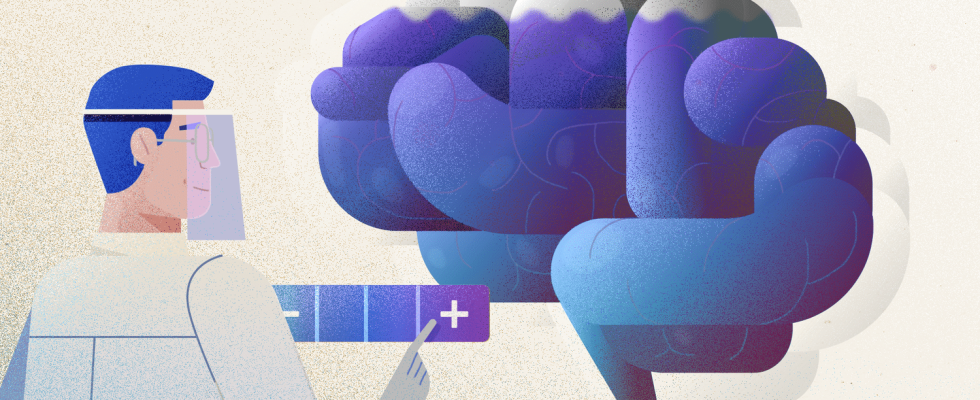Published
Reading time: 4 min

This received idea, according to which the human brain is under-exploited, has for years found a certain echo among the general public and in popular culture. But it has no scientific basis.
We only use 10% of our brain… that’s the slogan of an advertisement for a famous supermarket brand. With this small tenth, human beings would have mastered fire and electricity, invented the locomotive and artificial intelligence… Ten percent already well used, then. “It’s big fake news”, assures Christophe Rodo, neuroscientist and popularizer. The author of the podcast “The Head in the Brain” sees this “one of the oldest health theories”. This preconceived idea, which has now become part of popular culture, does not actually have any scientific basis.
This thesis was based on erroneous or exaggerated interpretations of real studies, explains Christophe Rodo. The technique has long allowed scientists to observe that humans use their entire brain. “It has been proven for years via brain imaging techniques, electrodes, magnetic techniques”, underlines Catherine Del Negro, researcher in neuroscience at Paris-Saclay University. These methods allow us to see that every cell in our brain is used, even if all areas of it are not active at the same time.
A “neuromyth” with a hard life
Certain regions of the brain are in fact used during specific activities, explains the National Museum of Natural History. “Certain areas are dedicated to speaking, reading, writing”, Catherine Del Negro list. “If all areas of the brain were stimulated at the same time, it would cause a full-blown epileptic seizure”notes the researcher. However, no study on this geography of the brain suggests the idea of a maximum threshold of 10%. And just because some areas are more active doesn’t mean they’re the only ones being used.
“During these activities, the rest of the brain is not turned off; it is still possible to capture brain activity in these areas.”
Catherine Del Negro, researcherat franceinfo
Another possible explanation for the theory: glial cells. They support, protect and insulate neurons. The latter have long been considered inactive. Hence the theory that a large part of our brain is unused? A study published in the scientific journal Medicine/science in January 2021 contradicts this idea. They are “one of the major elements of the central nervous system” reveal the authors. Considering them as an inactive part of the brain is therefore incorrect.
Studying brain-damaged patients is another way to dispel the myth. “When a person has suffered a stroke, they often have brain damage with physical after-effects, for example an impact on speech, vision”remarks Christophe Roto.
“Thousands of studies of people with brain injuries have demonstrated that no area of the brain is useless.”
Christophe Rodo, neuroscientistat franceinfo
This idea according to which we only use 10% of our cognitive capacities thus constitutes what we call a “neuromyth”, an erroneous belief about the human brain. Its source is old and it is difficult to trace its exact origin. “Some associate him with Albert Einstein, others with William James, one of the founding fathers of psychology”, notes Christophe Rodo. But no matter how much we search in the writings of the two men, we find no trace of this theory. For Catherine Del Negro, it could find its origin in the frontal lobotomies practiced in the 1950s. “The patients who had this operation had no lesions at first, which is why some believed that a large part of the brain was useless”she says. “However, the patients had many after-effects, particularly concerning the social aspect.”
A theory that has entered pop culture
Even if it is false, this idea has entered popular culture and is widely disseminated and amplified by films like Lucy by Luc Besson. This theory remains vague and over the years several variants have developed: Christophe Rodo distinguishes three. Some people think that humans only use 10% of our brain cells and that the remaining 90% are inactive. Others, that we can only use 10% of our brain at a time. The third version, the most mystical, postulates that we use all areas of our brain, but only 10% of its potential and that in reality, our cerebral organ would be capable of much more. It is this idea which is taken up in the film Lucy. We would then transform ourselves into superheroes, capable of moving objects by thought, speaking several languages without even learning them, having all the knowledge in the world within our reach… This unlimited knowledge would be inaccessible to us because of a mental barrier.
“It is easy to think of the brain as a library in which we accumulate information, creating new neuronal connections”, and therefore to imagine being able to fill it as much as possible, to the point of pushing the limits, agrees Catherine Del Negro. “That’s not how the brain works. It changes throughout life, but it’s always fully utilized.”she sweeps away.
“This theory is a caricature of the brain, which is a very complex organ.”
Catherine Del Negro, researcherat franceinfo
The popularity of this thesis is undoubtedly due to the ideal it holds out. “The ‘neuromyths’ promise something enviable: that we can become better”explains Christophe Rodo. “A ‘neuromyth’ is like a good horoscope, it must be sufficiently vague in its formulation so that everyone can give it an interpretation that suits them.” So, one thing is certain: you can continue to develop your knowledge, but you will not become a superhero… You are already using 100% of your brain.
